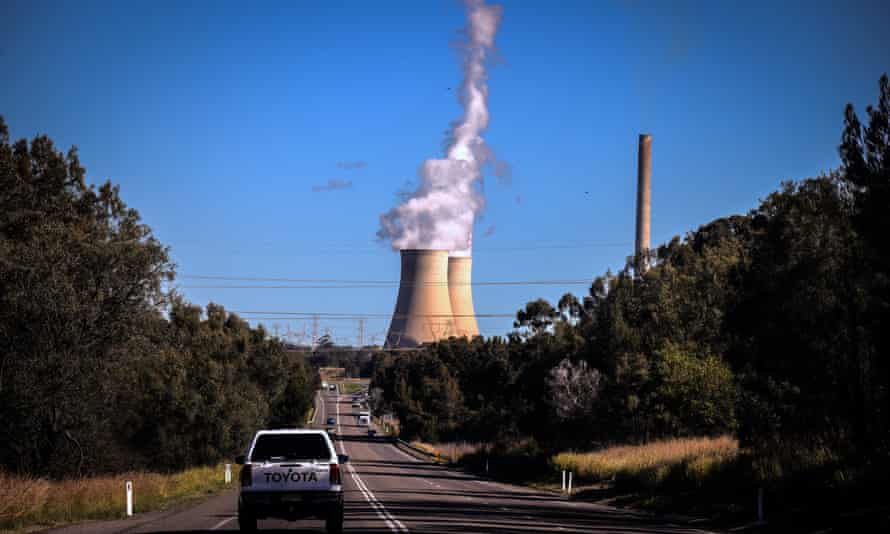A 2030 target of between 50% and 74% is needed to limit global heating to 2C and 1.5C respectively, the Climate Targets Panel says

Last modified on Thu 28 Jan 2021 03.32 AEDT
Australia will effectively be abandoning the Paris agreement unless it makes at least a 50% cut in greenhouse gas emissions by 2030 and reaches net zero well before 2050, according to an analysis by policymakers and scientists.
A report by a new group calling itself the Climate Targets Panel found the Morrison government should be setting a 2030 emissions reduction target of between 50% and 74% if Australia was to comply with goals of limiting global heating to 2C and 1.5C respectively.
Both would be a significant increase on the Morrison government’s existing target of a 26-28% cut compared with 2005 levels, and the 45% goal Labor took to the last election.
The panel, consisting of the former Liberal leader John Hewson and scientists Will Steffen, Lesley Hughes and Malte Meinshausen, said it employed the same carbon budget methodology as the Climate Change Authority used in a 2014 report that advised the then Abbott government on targets.
Hewson said it found Australia would have to effectively double its 2030 target to play its part in meeting the Paris agreement goals (expressed as holding the average global temperature increase since pre-industrial times to well below 2C and pursuing efforts to limit it to 1.5C).
He said decisions on climate targets were being driven by political expediency, not science. That included the push for a target of net-zero emissions by 2050, which the Morrison government has so far resisted despite calls from international leaders, the scientific community, major business groups, the opposition and state governments.
The panel found Australia’s fair share to hold global heating to below 2C would be to reach net-zero emissions by 2045.
It said interim targets would need to be a 50% cut by 2030, 67% by 2035 and 84% by 2040.
Limiting heating to 1.5C would require a 74% cut by 2030 leading to net-zero emissions by 2035.
“Anything less than a 50% cut on 2005 levels by 2030 is abandoning the Paris agreement,” Hewson said.
The global research body Climate Analytics looked at the same question last year and found Australia should be making a 66% cut below 2005 levels by 2030 on the path to net zero by 2050. That report suggested decarbonising the energy system could create 76,000 jobs in the renewables sector alone.
Pressure on countries to increase climate targets, including commitments for 2030, is expected to increase this year. In the US, the new president, Joe Biden, has reset a goal of power generation in the US being carbon-free by 2035 and is expected to announce a 2030 target ahead of the November climate conference in Glasgow.
Britain and the European Union late last year announced new emissions reduction targets for 2030 of 68% and 55% (compared with 1990 levels) respectively.
But Scott Morrison has indicated he does not plan to announce a new 2030 or 2035 target for Australia this year, and the Coalition is engaged in an internal political argument over the Nationals’ desire for the government to financially support a new coal power station.
Climate Targets Panel member Prof Will Steffen, an Australian National University professor and climate councillor, said the analysis showed the climate crisis was far more urgent than many people realised. “We certainly can’t afford to push climate action out to 2050,” he said.
The carbon budget approach involves estimating the total amount Australia could reasonably emit before reaching net zero under a global climate deal in which every country played their part.
The panel used the budgets to calculate targets using “straight-line trajectories” – drawing a straight-line from 2020 to the point at which the national budget ran out and the country would be at net-zero emissions.
It found if Australia aimed to reach net zero emissions by 2050 – a mark supported by more than 120 countries – it would have used up its entire emissions budget well before mid-century.
The report said it was beyond the panel’s scope to consider the adequacy of other countries’ targets, but for Australia a net zero by 2050 goal “would blow our remaining emissions budget”.
An analysis by ClimateWorks Australia last year found the falling cost of technology suggested the country could reach net-zero emissions by 2035 if governments directed stimulus spending to climate solutions.
A parliamentary inquiry into climate change legislation proposed by the independent MP Zali Steggall, which includes a 2050 net zero target and would require the government to set a rolling emissions budget to meet it, is due to hold hearings on Friday and Monday.
No comments:
Post a Comment